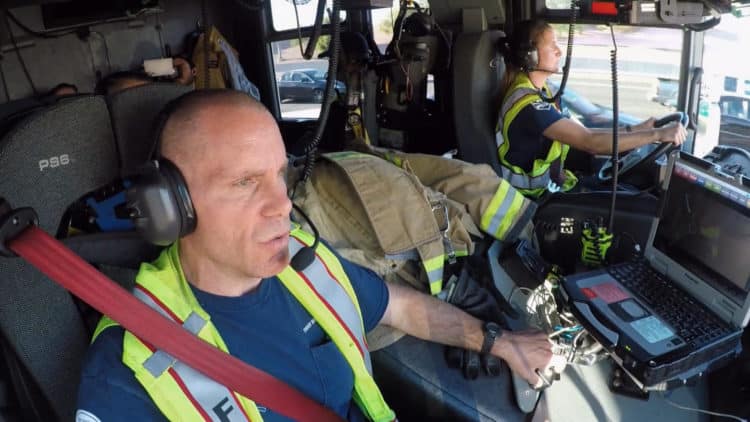
From the inception of Live PD it was inevitable that there would follow a number spinoffs that would capture the essence of the show while exploring different dimensions of the work of first responders throughout the country. Cable channel A&E introduced its viewers to the concept several years ago, and the interest in the show measured by the ratings warranted one spinoff after another. Live Rescue preceded Emergency Response because like Live PD the shows were 30 minute episodes that followed actual, live, unedited videos of police and firemen doing their work.
Where Live Rescue left off, Emergency Response picked up. The real problem with television shows that pass themselves off as members of the Reality TV genre is that they are mainly competitions rather than real events. All of the spinoffs of Live PD are not competing against one another but individual shows featuring individual events that take place in real time. The 911 dispatcher calls are just as real as the first responders who risk their lives rushing to the scene. There are a number of reporters situated around the country at predetermined locations to avoid the show from becoming boring.
There is no script to follow either for the producers of the show or the real first responders who are meeting the challenges head on. This lack of a script shows that the viewer will be able to witness what is going on in real time — or as close to it as someone can get. The drama begins and ends with each broadcast of the show, and tomorrow’s series of events and outcomes are as unpredictable as the people who are personally dealing with the drama.
While most of the Live shows focus on the action and events, Emergency Response is said to provide “an unflinching look” at the work of first responders. There are a variety of scenarios they walk into, everything from rescuing people caught in a flash flood to two senior citizens engaged in a fight. The latter of these examples may seem somewhat comical, but that is the whole point of the show. Of course, if either or both of these senior citizens are injured, that compounds the problem for first responders. But there are so many unique scenarios that play out, it is almost a must to tune in and see if the show is something that meets your criteria for action and adventure.
Staying consistent with the Reality TV show genre, the show also offers some personal insight to the lives of these first responders. We often wonder why people choose to commit themselves to being firefighters or law enforcement officials as a career, and instead of getting the canned response often heard on other shows, the responses of Emergency Response are generally genuine and unrehearsed. This makes the individual responses both inspiring but also cautionary. A policeman may be willing to risk their life to protect and serve, but getting shot at is a reality not everyone is willing to do.
Viewers are exposed to scenarios they may not often encounter. For example, people who are fortunate enough to live in areas where flash flooding is rare or non-existent may find it hard to relate to the very real dangers and speed at which a flash flood can occur. Watching Emergency Response helps to enlighten the viewers about situations they may encounter only once in a lifetime, but offer some insight on how to deal with the situation. Life is a learning process, and for most people that learning takes place through experience.
Thus far there have been 8 Emergency Response shows, following in the footsteps of its parent Live Rescue, averaging more than 1 million viewers each week. That means there are a lot more to come, in part because the viewer preference has been for Emergency Response. Where the show apparently has found a place in the viewer’s hearts is that it seems to be more focused on the people rather than the event. There are victims, perpetrators, young, old, men, women, and just about everything in-between. Because it searches for the most live action anywhere across the country, you can have a firsthand experience from meeting people all around the country. Some call this a kind of reality TV diversity since neither the producers or the responders can know who or what to expect on any given day.
A final thought on what makes Live Rescue: Emergency Responders so compelling is that we see normal people sometimes dealing with extraordinary situations and handling them with courage and hope. After watching a number of episodes you start forgetting about the old adage, “It will never happen to me” and begin thinking that you are just as normal as everyone else. There are certain things in life we can control — and there is everything else. No one plans to be a member of the Emergency Responder cast, but that is what makes tuning in regularly a personal adventure.
Since the show airs Monday at 9 p.m. on A&E, it is a great way to end the beginning of the week. First responders generally work longer shifts than most 9 to 5 people, finding themselves at the job 12 hours a day. In many ways the job of a first responder is similar to being in a pressure cooker since the demands on them physically and emotionally can ratchet up high and fast. Add to that reality that there is no end to the job; that those 12 hours shifts will return again next week — perhaps on different days — and it takes a true commitment to do the job year after year. As you sit in your lounger and watch the efforts of these first responders, keep in mind that in the event you need help when your home is robbed or a tornado unexpectedly hits town that these people continue to be ready to be there for you.Live PD
 Follow Us
Follow Us





